
PRODUCTS
Soy lecithin liquid is a natural lecithin mixture e……
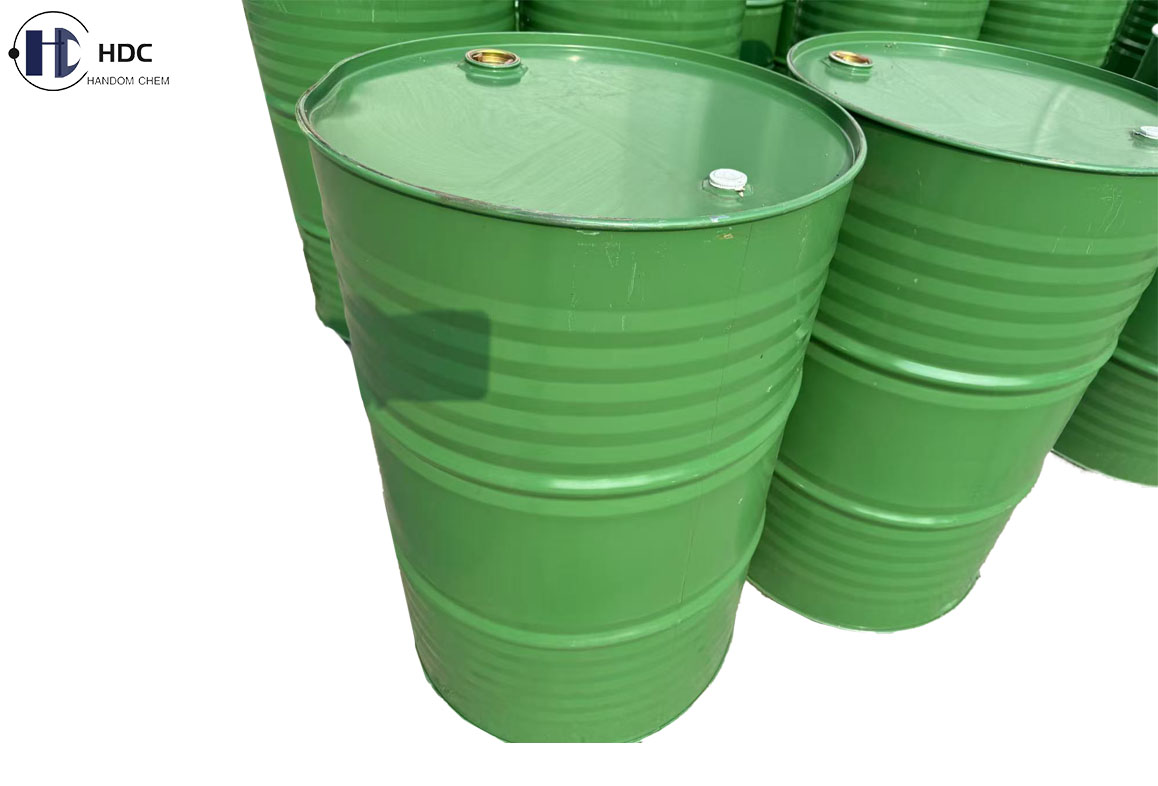
Soybean lecithin powder, also called soya lecithin ……
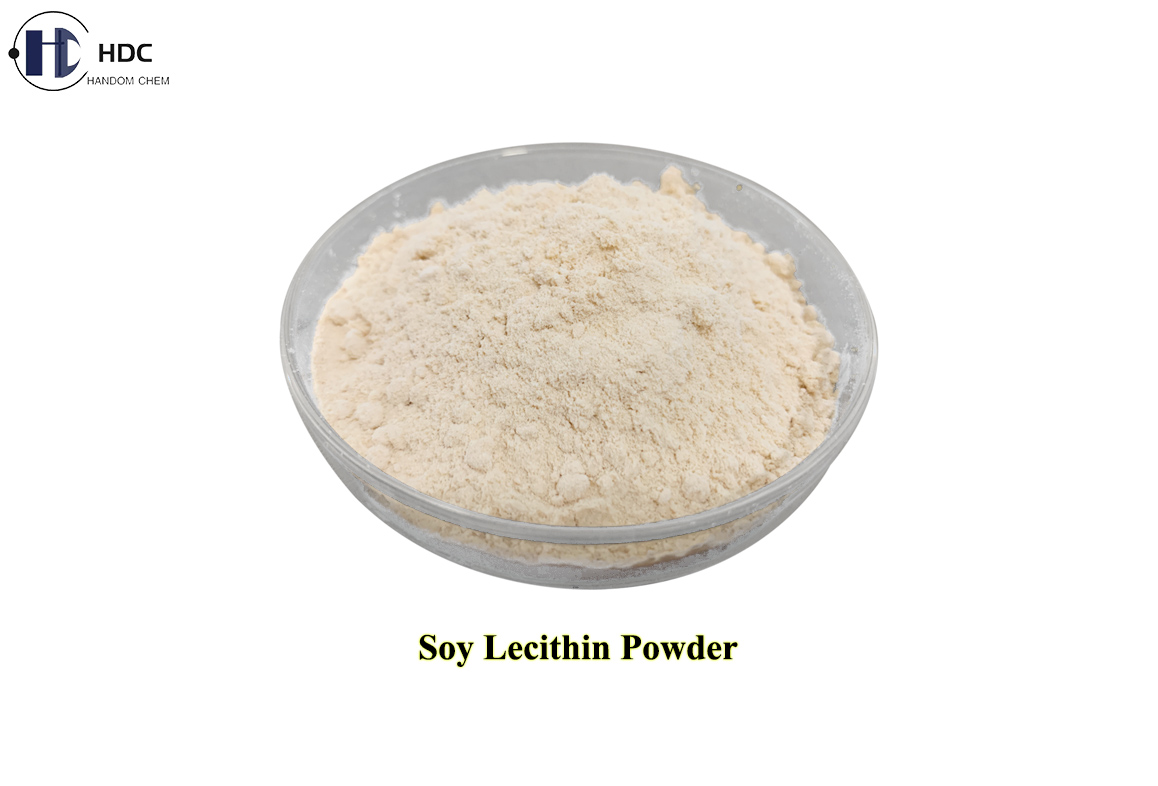
Product Name: Chitosan AzelateGrade: Cosmetic Grade……
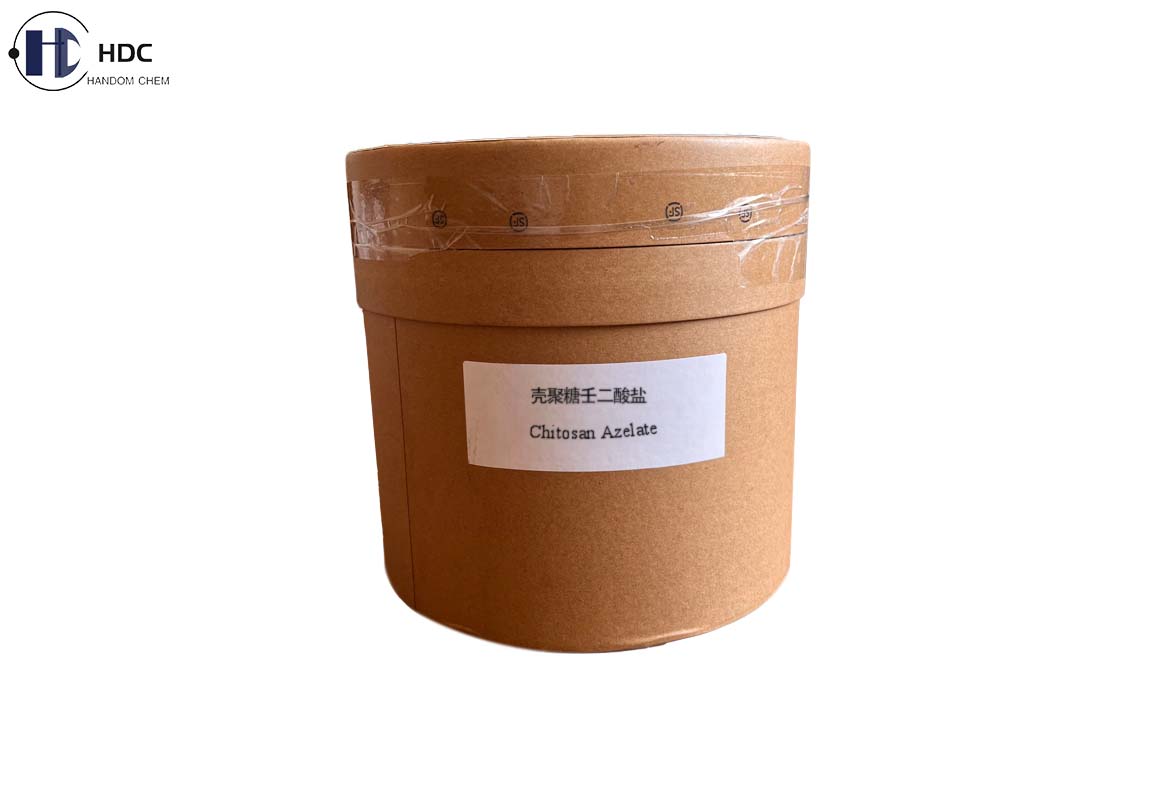
Commodity Name: IscotrizinolChemical Name: Diethylh……
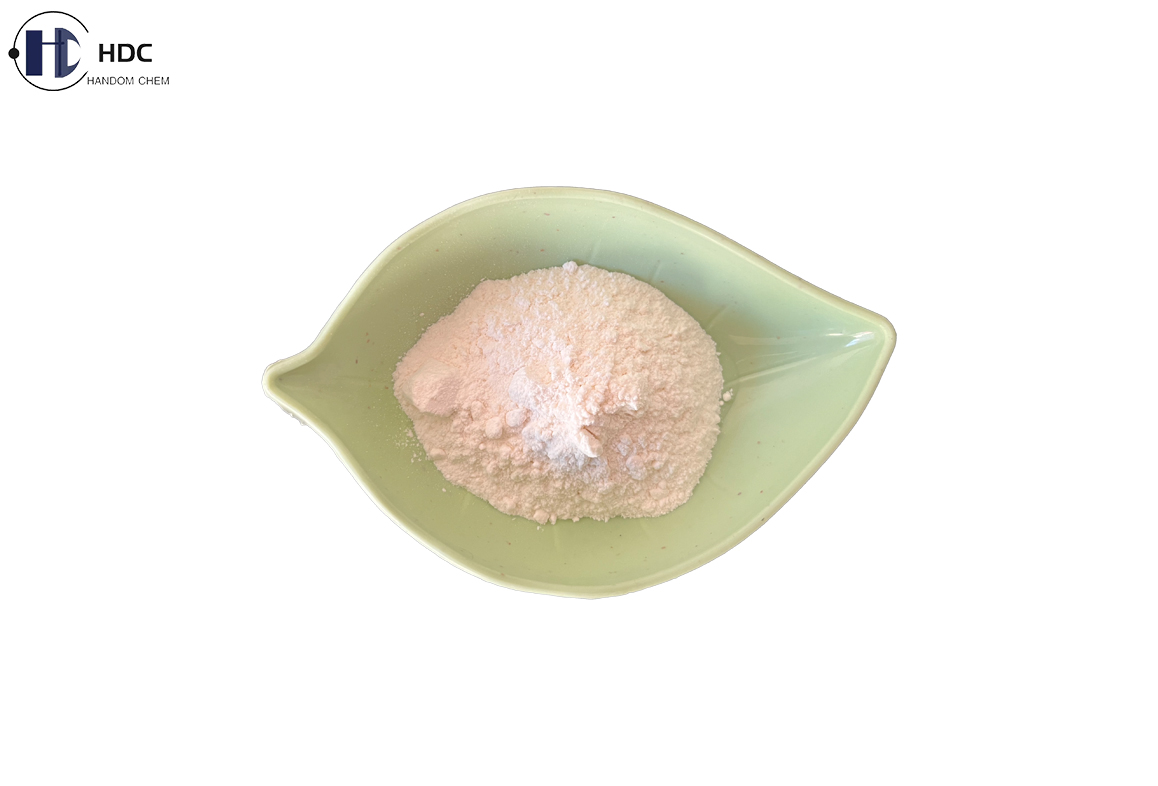
Product Name: Milk Thistle Extract
Extracted From: Silybum marianum (L.) Gaertn.
Plant Background: Milk thistle belongs to the Asteraceae family, native to the Mediterranean, and now distributed worldwide. Its seeds are the source of extraction.
Active Ingredients: The core ingredient is Silymarin (a mixture of flavonoid lignans), of which Silybin accounts for 50%-70% and is the main active substance.
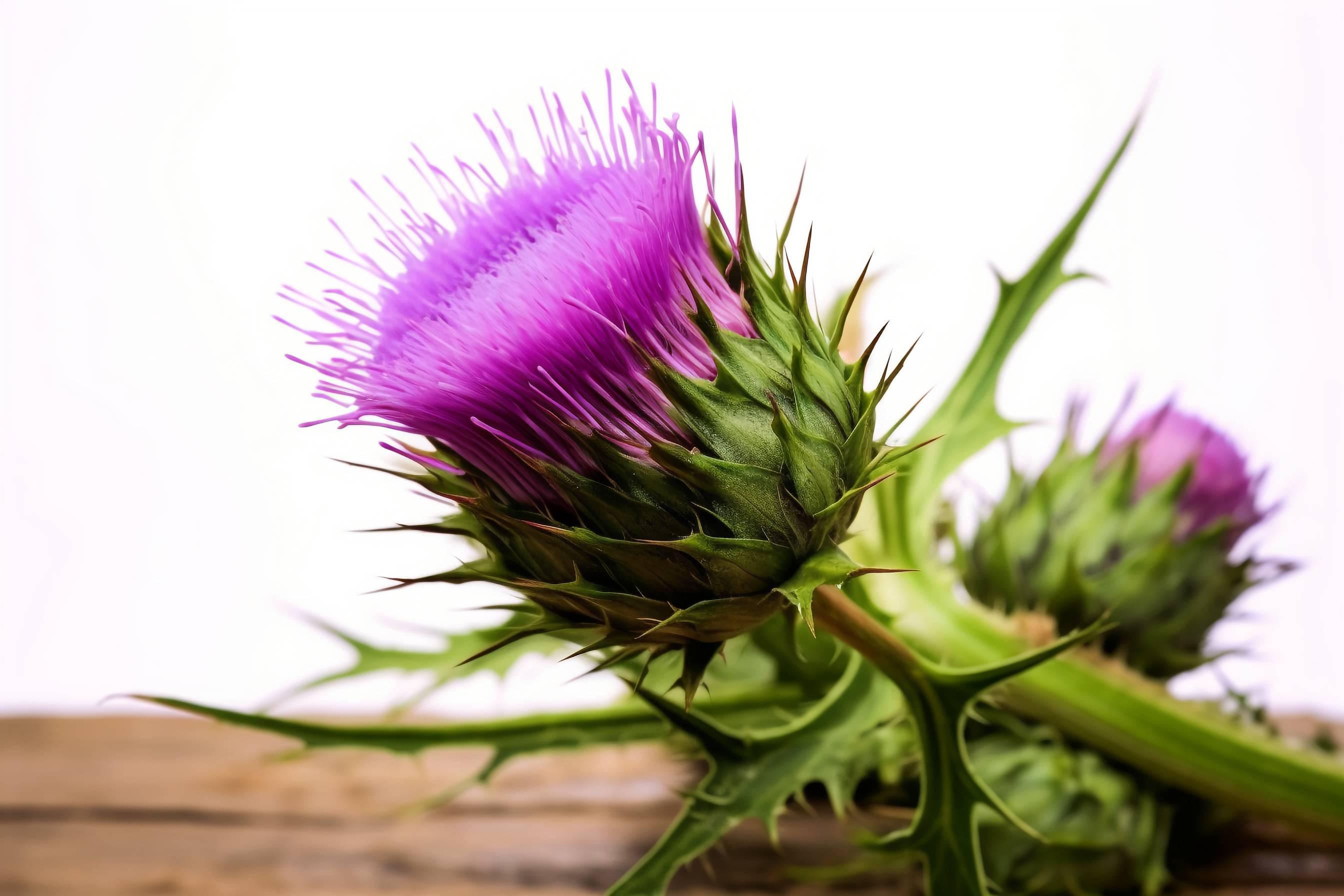
Brief Introduction:
Milk thistle extract is a compound separated and refined from the whole herb and seeds of the Asteraceae plant Silybum marianum (L.) Gaertn. Milk thistle is an annual or biennial herb native to southern Europe and North Africa, which has a history of cultivation and use in Europe and Africa for thousands of years. It began to be planted in China in the 1980s and was later planted in large quantities in Shaanxi, Hebei, Jiangsu, Northeast China and other places. Milk thistle extract is mainly used for liver protection, anti-oxidation and blood sugar regulation.
Mechanism of Action:
1) Antioxidant: Neutralizes free radicals and reduces oxidative stress.
2) Anti-inflammatory: Inhibits inflammatory factors (such as TNF-α, IL-6).
3) Liver Protection: Stabilizes liver cell membranes, promotes liver regeneration, and inhibits damage caused by toxins (such as alcohol and poisonous mushrooms).
All Types of our Milk Thistle Extract:
| Silymarin Extracted by Acetone (CAS No.: 65666-07-1) | UV 80% ~ UV 90% | HPLC 40% ~ HPLC 60% | |
| UV 80% |
HPLC 45% |
Silybin & Isosilybin 30% |
|
| UV 80% |
HPLC 50% |
Silybin 30% (Silybin A+Silybin B) |
|
| UV 85% |
HPLC 55% |
Silybin 35% (Silybin A+Silybin B) |
|
| UV 85% |
HPLC 60% |
|
|
| Silymarin Extracted by Ethanol (CAS No.: 65666-07-1) | UV 80% |
HPLC 45% |
Silybin & Isosilybin 30% |
| UV 80% |
HPLC 50% |
Silybin 30% (Silybin A+Silybin B) |
|
| UV 85% |
HPLC 55% |
Silybin 35% (Silybin A+Silybin B) |
|
| UV 85% |
HPLC 60% |
|
|
| Silymarin Extracted by Ethyl Acetate (CAS No.: 65666-07-1) | UV 80% |
HPLC 45% |
Silybin & Isosilybin 30% |
| UV 80% |
HPLC 50% |
Silybin 30% (Silybin A+Silybin B) |
|
| UV 85% |
HPLC 55% |
Silybin 35% (Silybin A+Silybin B) |
|
|
UV 85% |
HPLC 60% |
|
|
| Water-Soluble Silymarin (CAS No.: 65666-07-1) | UV 20% | ||
| UV 40% | |||
| UV 45% | |||
| Silybin (CAS No.: 22888-70-6) | Silybin 70% | ||
| Silybin 80% | |||
| Silybin 90% | |||
| Silybin 95% | |||
| Silybin 98% | |||
| Organic Milk Thistle Extract | UV 70% | ||
| Silymarin Granules |
1. Silymarin Granules or Milk Thistle Oil Microencapsulated Powder is processed and produced according to the customers' requirements for the particle size of silymarin, which is convenient for customers to directly fill capsules or compress tablets. 2. Conventional Silymarin Powder does not have good fluidity, so Silymarin Granules make up for this shortcoming. |
||
| Milk Thistle Oil Microencapsulated Powder | |||
Specifications of our Silymarin UV 80% (Milk Thistle P.E.):
| Appearance |
Amorphous powder |
|
| Colour |
Yellow to yellowish-brown |
|
| Odour |
Slight, Specific |
|
|
Solubility |
In Water |
Practically insoluble |
| In Methanol and Acetone |
Soluble |
|
|
Identification |
A. Passes TLC Test | |
| B. Passes HPLC Identification Test | ||
| Sulphated Ash |
Not more than 0.5% |
|
| Heavy Metals |
Not more than 10 ppm |
|
| Lead (Pb) |
Not more than 2.0 ppm |
|
| Cadmium (Cd) |
Not more than 1.0 ppm |
|
|
Mercury (Hg) |
Not more than 0.1 ppm |
|
|
Arsenic (As) |
Not more than 1.0 ppm |
|
|
Loss on Drying (2 hours, 105℃) |
Not more than 5.0% |
|
|
Particle Size |
95% pass through 80 mesh sieve |
|
|
Assay of Silymarin (UV test, per cent, Standard in House) |
Not less than 80% |
|
| Assay of Silymarin (Test by HPLC) |
|
|
| -sum of Silycristin and Silydianin |
|
|
| -sum of Silybin A and Silybin B |
|
|
|
-sum of Isosilybin A and Isosilybin B |
|
|
|
Residual Solvents |
n-Hexane |
Not more than 290 ppm |
| Acetone |
Not more than 5000 ppm |
|
| Ethanol |
Not more than 5000 ppm |
|
| Pesticide Residues |
According to the Standard of USP43<561> |
|
| Microbiological Limits | Total Aerobic Microbial Count |
Not more than 1000 CFU/g |
| Total combined Yeasts & Mould Count |
Not more than 100 CFU/g |
|
| Escherichia coli |
Negative/g |
|
| Salmonella |
Negative/g |
|
| Staphylococcus aureus |
Negative/g |
|
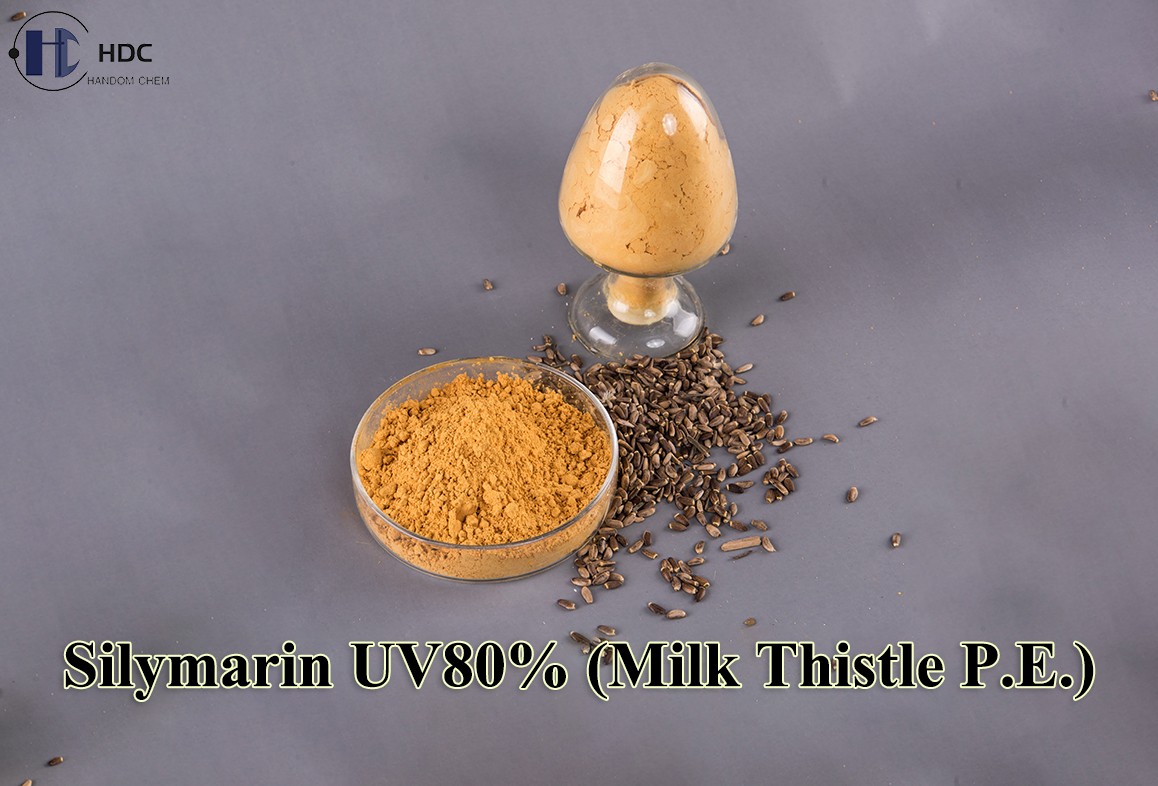
Specifications of our Silybin & Isosilybin 30% (Milk Thistle P.E.):
Appearance
Amorphous powder
Colour
Yellow to yellowish-brown
Odour
Slight, specific
Solubility
In Water
Practically insoluble
In Methanol and Acetone
Soluble
Identification
A. Passes TLC Test
B. Passes HPLC Identification Test
Sulphated Ash
Not more than 0.5%
Heavy Metals
Not more than 10 ppm
Lead (Pb)
Not more than 2.0 ppm
Cadmium (Cd)
Not more than 1.0 ppm
Mercury (Hg)
Not more than 0.1 ppm
Arsenic (As)
Not more than 1.0 ppm
Loss on Drying (2 hours, 105℃)
Not more than 5.0%
Particle Size
95% pass through 80 mesh sieve
Assay of Silymarin (UV test, per cent, Standard in House)
Not less than 80%
Assay of Silymarin (Test by HPLC)
-sum of Silycristin and Silydianin
-sum of Silybin A and Silybin B
-sum of Isosilybin A and Isosilybin B
Residual Solvents
n-Hexane
Not more than 290 ppm
Acetone
Not more than 5000 ppm
Ethanol
Not more than 5000 ppm
Ethyl Acetate
Not more than 5000 ppm
Pesticide Residues
According to the Standard of USP43<561>
Microbiological Limits
Total Aerobic Microbial Count
Not more than 1000 CFU/g
Total combined Yeasts & Mould Count
Not more than 100 CFU/g
Escherichia coli
Negative/g
Salmonella
Negative/g
Staphylococcus aureus
Negative/g
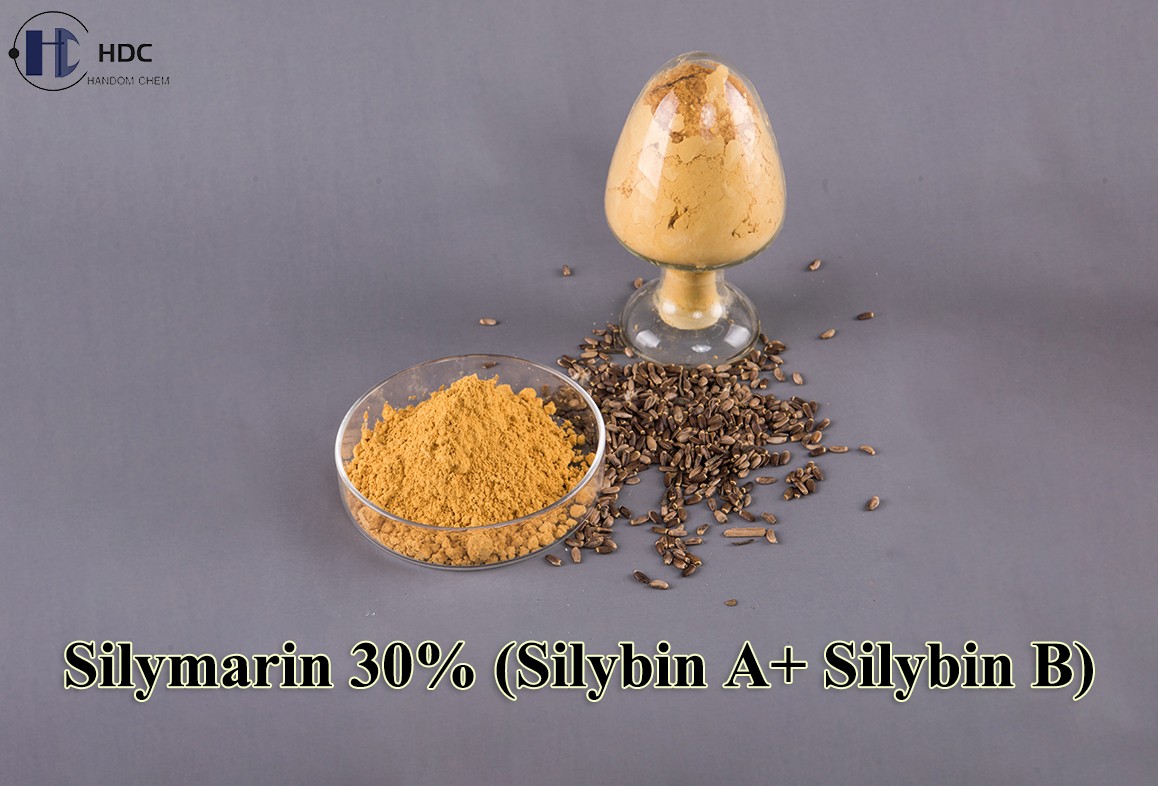
Specifications of our Silymarin HPLC 50% (Milk Thistle P.E.):
Appearance
Amorphous powder
Colour
Yellow to yellowish-brown
Odour
Slight, specific
Solubility
In Water
Practically insoluble
In Methanol and Acetone
Soluble
Identification
A. Passes TLC Test
B. Passes HPLC Identification Test
Sulphated Ash
Not more than 0.5%
Heavy Metals
Not more than 10 ppm
Lead (Pb)
Not more than 2.0 ppm
Cadmium (Cd)
Not more than 1.0 ppm
Mercury (Hg)
Not more than 0.1 ppm
Arsenic (As)
Not more than 1.0 ppm
Loss on Drying (2 hours, 105℃)
Not more than 5.0%
Particle Size
95% pass through 80 mesh sieve
Assay of Silymarin (UV test, per cent, Standard in House)
Not less than 80%
Assay of Silymarin (Test by HPLC)
-sum of Silycristin and Silydianin
-sum of Silybin A and Silybin B
-sum of Isosilybin A and Isosilybin B
Residual Solvents
n-Hexane
Not more than 290 ppm
Acetone
Not more than 5000 ppm
Ethanol
Not more than 5000 ppm
Pesticide Residues
According to the Standard of USP43<561>
Microbiological Limits
Total Aerobic Microbial Count
Not more than 1000 CFU/g
Total combined Yeasts & Mould Count
Not more than 100 CFU/g
Escherichia coli
Negative/g
Salmonella
Negative/g
Staphylococcus aureus
Negative/g
Specifications of our Water-Soluble Silymarin UV 40% (Milk Thistle P.E.):
Assay of Silymarin (UV test, per cent, Standard in House)
Not less than 40.0%
Appearance
Yellow to yellowish-brown powder
Odour & Taste
Characteristic
Solubility in Water (1g/100mL)
. soluble
Sulphated Ash
Not more than 0.5%
Loss on Drying (2 hours, 105℃)
Not more than 5.0%
Heavy Metals
Not more than 10 ppm
Lead (Pb)
Not more than 2.0 ppm
Cadmium (Cd)
Not more than 1.0 ppm
Mercury (Hg)
Not more than 0.1 ppm
Arsenic (As)
Not more than 1.0 ppm
Particle Size
95% pass through 80 mesh sieve
Pesticide Residues
According to the Standard of USP43<561>
Microbiological Limits
Total Aerobic Microbial Count
Not more than 1000 CFU/g
Total combined Yeasts & Mould Count
Not more than 100 CFU/g
Escherichia coli
Negative/g
Salmonella
Negative/g
Staphylococcus aureus
Negative/g
Benefits and Uses of Milk Thistle Extract:
1. Liver Protection:
Milk thistle extract has the effect of protecting liver, mainly due to Silybin and Isosilybin (rich in flavonoids), these ingredients have the ability to resist oxidation and scavenge free radicals, protect liver cell membranes from damage, reduce liver cell damage and induce apoptosis, thereby maintaining the stability of liver cells and the normal physiological function of the liver. Therefore, it is widely used in many kinds of liver protection products.
2. Antioxidant:
Its powerful antioxidant properties can neutralize free radicals and reduce oxidative stress damage to cells, this can help prevent the occurrence of chronic diseases. It can also prevent skin aging, damage and pigmentation, and is used in cosmetics.
3. Regulate Blood Sugar:
Some studies have shown that milk thistle may play a role in improving insulin sensitivity and lowering blood sugar levels, but more research in this area is needed.
4. Anti-inflammatory:
Milk thistle extract has potential anti-inflammatory effects and can help alleviate the symptoms of inflammatory-related diseases. It can also reduce discomfort such as redness, itching and allergies, making the skin more comfortable.
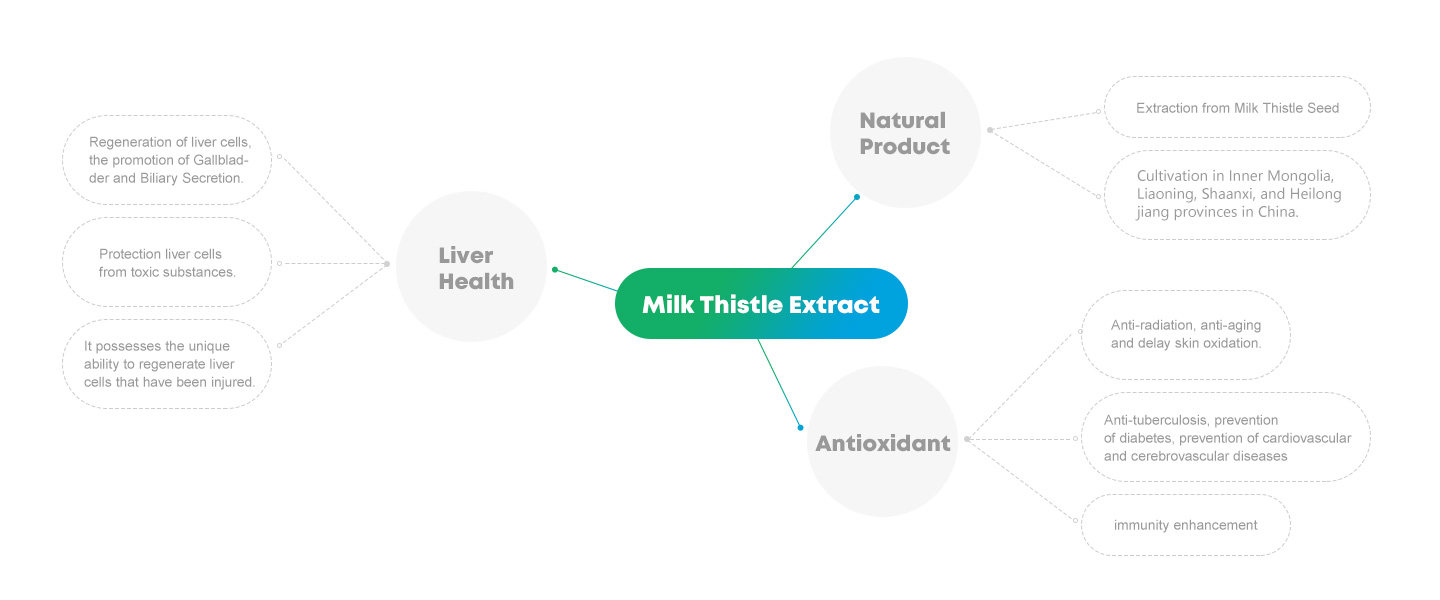
Packaging:
50g/Aluminum Foil Bag, 100g/Aluminum Foil Bag, 200g/Aluminum Foil Bag, 500g/Aluminum Foil Bag, 1kg/Aluminum Foil Bag, 5kg/Carton, 10kg/Carton, 20kg/Cardboard Drum, 25kg/Cardboard Drum or according to the specific requirements from customers.
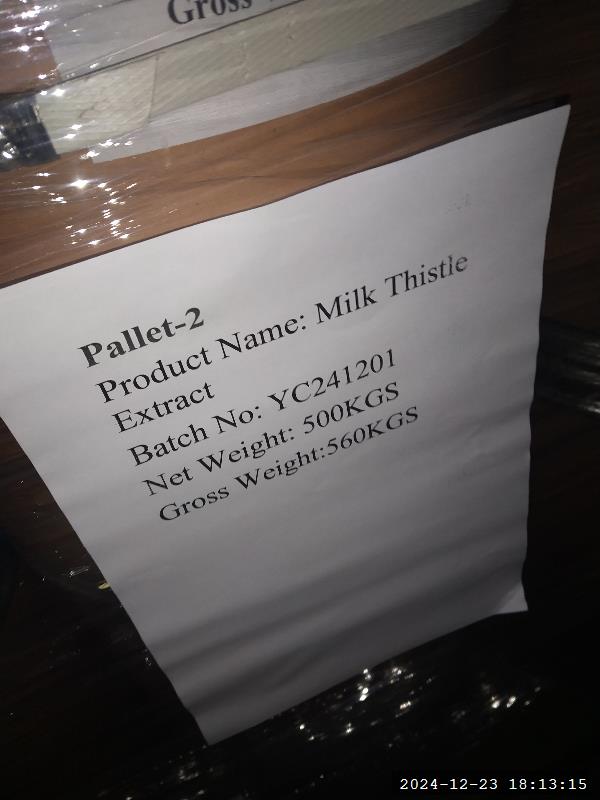
Storage Conditions:
Stored in airtight containers in a cool dry place before using; kept away from direct sunlight, heat and moisture.
Shelf Life:
36 months from the date of manufacturing when stored under the above conditions.